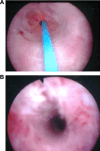Low-power holmium:YAG laser urethrotomy for urethral stricture disease: comparison of outcomes with the cold-knife technique
- PMID: 22005159
- PMCID: PMC11916411
- DOI: 10.1016/j.kjms.2011.06.013
Low-power holmium:YAG laser urethrotomy for urethral stricture disease: comparison of outcomes with the cold-knife technique
Abstract
In this prospective randomized clinical trial, we aimed to evaluate the safety and efficacy of endourethrotomy with holmium:yttrium-aluminium-garnet (HO:YAG) laser and compare the outcomes with the conventional cold-knife urethrotomy. Fifty-one male patients with single, iatrogenic, annular strictures of the urethra were randomly divided into two groups; 21 patients who underwent direct-vision endoscopic urethrotomy with Ho:YAG laser (15 W; 1,200-1,400 mJ; 8-12 Hz) at 12 o'clock position (laser group) and 30 patients who underwent direct-vision endoscopic urethrotomy with cold-knife incision at 12 o'clock position (cold-knife group). The results obtained were analyzed and compared at 3 months, 6 months, 9 months, and 12 months postoperatively by clinical evaluation, uroflowmetry, and retrograde urethrographies. Variables were compared among groups using Fisher's exact and Mann Whitney U tests. There were no differences between two groups in terms of patient age, preoperative Qmax value, stricture location, and length. Operative time was shorter in laser group (16.4 ± 8.04 minutes) when compared with cold-knife group (23.8 ± 5.47 minutes) (p<0.001). Recurrence-free rate at 3 months was similar between two groups (p=0.122). However, recurrence-free rates at 6 months, 9 months, and 12 months were significantly higher in laser group when compared with cold-knife group (p values were 0.045, 0.027, and 0.04, respectively). No intra- or postoperative complications were encountered. Use of Ho:YAG laser in the management of urethral stricture disease is a safe and effective method. In addition, it provides shorter operative time and lower recurrence rate when compared with the conventional technique.
Copyright © 2011. Published by Elsevier B.V.
Figures


Similar articles
-
Comparison between cold knife and laser urethrotomy for urethral stricture: a systematic review and meta-analysis of comparative trials.World J Urol. 2019 Dec;37(12):2785-2793. doi: 10.1007/s00345-019-02729-3. Epub 2019 Mar 20. World J Urol. 2019. PMID: 30895360
-
Comparative analysis of holmium: YAG laser internal urethrotomy versus Cold-Knife optical internal urethrotomy in the management of urethral stricture - a systematic review and meta-analysis.Int J Surg. 2024 Jul 1;110(7):4382-4392. doi: 10.1097/JS9.0000000000001384. Int J Surg. 2024. PMID: 38573099 Free PMC article.
-
Visual internal urethrotomy for management of urethral strictures in boys: a comparison of short-term outcome of holmium laser versus cold knife.Int Urol Nephrol. 2018 Apr;50(4):605-609. doi: 10.1007/s11255-018-1809-x. Epub 2018 Feb 3. Int Urol Nephrol. 2018. PMID: 29397549
-
Use of holmium laser for urethral strictures in pediatrics: A prospective study.J Pediatr Urol. 2016 Feb;12(1):42.e1-6. doi: 10.1016/j.jpurol.2015.06.016. Epub 2015 Aug 11. J Pediatr Urol. 2016. PMID: 26302829
-
Holmium laser versus cold knife visual internal urethrotomy for management of short segment urethral stricture: a prospective randomized clinical trial.World J Urol. 2023 Jul;41(7):1897-1904. doi: 10.1007/s00345-023-04434-8. Epub 2023 May 31. World J Urol. 2023. PMID: 37256320 Free PMC article. Clinical Trial.
Cited by
-
Treatment of urethral/bladder neck stricture after high-intensity focused ultrasound for prostate cancer with holmium: yttrium-aluminium-garnet laser.Int Neurourol J. 2013 Mar;17(1):24-9. doi: 10.5213/inj.2013.17.1.24. Epub 2013 Mar 31. Int Neurourol J. 2013. PMID: 23610708 Free PMC article.
-
Safety and efficacy of lasers compared to cold knife in direct visual internal urethrotomy: a systematic review and Meta-analysis.Lasers Med Sci. 2024 Aug 5;39(1):209. doi: 10.1007/s10103-024-04134-8. Lasers Med Sci. 2024. PMID: 39101963
-
Bipolar plasma vaporization using plasma-cutting and plasma-loop electrodes versus cold-knife transurethral incision for the treatment of posterior urethral stricture: a prospective, randomized study.Clinics (Sao Paulo). 2016 Jan;71(1):1-4. doi: 10.6061/clinics/2016(01)01. Clinics (Sao Paulo). 2016. PMID: 26872076 Free PMC article. Clinical Trial.
-
Clinical Efficacy Study of Green Light Top-Firing Sharp for the Treatment of Short-Segment Urethral Strictures in Men.Am J Mens Health. 2025 May-Jun;19(3):15579883251336094. doi: 10.1177/15579883251336094. Epub 2025 May 24. Am J Mens Health. 2025. PMID: 40413568 Free PMC article.
-
Comparison between cold knife and laser urethrotomy for urethral stricture: a systematic review and meta-analysis of comparative trials.World J Urol. 2019 Dec;37(12):2785-2793. doi: 10.1007/s00345-019-02729-3. Epub 2019 Mar 20. World J Urol. 2019. PMID: 30895360
References
-
- Jordan G.H., Devine P.C.. Management of urethral stricture disease. Urol Clin North Am. 1988; 15: 277–289.
-
- Gallentine M.L., Morey A.F.. FACS: imaging of the male uretra for stricture disease. Urol Clin North Am. 2002; 29: 361–372. - PubMed
-
- Sachse H.. Die transurethrale scharfe Schlitzung der Harnrohrenstriktur mit einem Sichturethrotom. Verhandl Deutsches Gesell Urol. 1973; 25: 143–146.
-
- Montorsi F., Naspro R., Salonia A., Suardi N., Briganti A., Zanoni M., et al. Holmium laser enucleation versus transurethral resection of the prostate: Results from a 2‐ center, prospective, randomized trial in patients with obstructive benign prostatic hyperplasia. J Urol. 2004; 172: 1926–1929. - PubMed
-
- Perkash I.. Ablation of urethral strictures using contact chisel crystal fıring neodymium:YAG laser. J Urol. 1997; 157: 809–813. - PubMed
Publication types
MeSH terms
LinkOut - more resources
Full Text Sources

